Physical Address
304 North Cardinal St.
Dorchester Center, MA 02124
The somatic soft tissues do not contain mature osteoblasts or chondrocytes, and these tissues do not typically contain bone or cartilage. However, under certain circumstances, undifferentiated mesenchymal cells are stimulated to differentiate into these specialized cells. This results in a variety of bone and cartilage matrix-producing tumors. These span the spectrum from previously considered reactive “quasi-tumors” through benign to frankly malignant neoplasms. This chapter deals with those soft tissue lesions that frequently harbor osseous and/or cartilaginous matrix. Extraskeletal myxoid chondrosarcoma, albeit lacking bone fide hyaline chondroid matrix, is included here for the convenience of reference.
Previously considered trauma-induced reactive proliferation, myositis ossificans (MO) and fibro-osseous pseudotumour of digits (FOPD) are now recognized as self-limited benign neoplasms that frequently harbor the COL1A1-USP6 fusion gene. Both tumor types share many common clinicopathologic features and may be regarded as variations of the same disease entity. On the other hand, the nosology of aneurysmal “bone” cyst of soft tissue (ABCST) is somewhat controversial, particularly in its relationship with and its distinction from MO. As ABCST bears remarkable clinicopathologic resemblance and molecular kinship to MO, it is increasingly recognized that ABCST may belong to the neoplastic spectrum that also includes MO and FOPD.
MO and FOPD typically occur in young adults. While MO seems to have a slight male predominance, FOPD is relatively common in females. Patients present with a short history (usually less than 3 months) of pain and/or swelling in the affected area. The lesion starts to mineralize weeks after the onset of symptoms and eventually becomes a hard and well-demarcated mass as the pain diminishes. Greater than 75% of cases of MO occur in the large skeletal muscles of proximal extremities (the quadriceps and the brachialis muscles are the most common sites). FOPD usually occurs in the subcutis of the proximal phalanges and predominates in the fingers and toes. Occasionally there may be localized erythema of the overlying skin. Not all patients recount a history of trauma to the site.
The radiologic appearance of MO varies depending on its degree of “maturity.” Early lesions exhibit a nonspecific soft tissue mass, where MRI typically reveals hyperintense signals on T2-weighted images. Intralesional hemorrhage and cystic formation, sometimes with fluid-fluid levels, may also be found, hence imparting an ABCST-like appearance. Later lesions appear as ossified soft tissue tumors, with the ossification typically starting from the periphery, thus assuming an egg shell-like picture ( Fig. 12.1A ). By contrast, the mineralization and ossification in FOPD is randomly distributed.
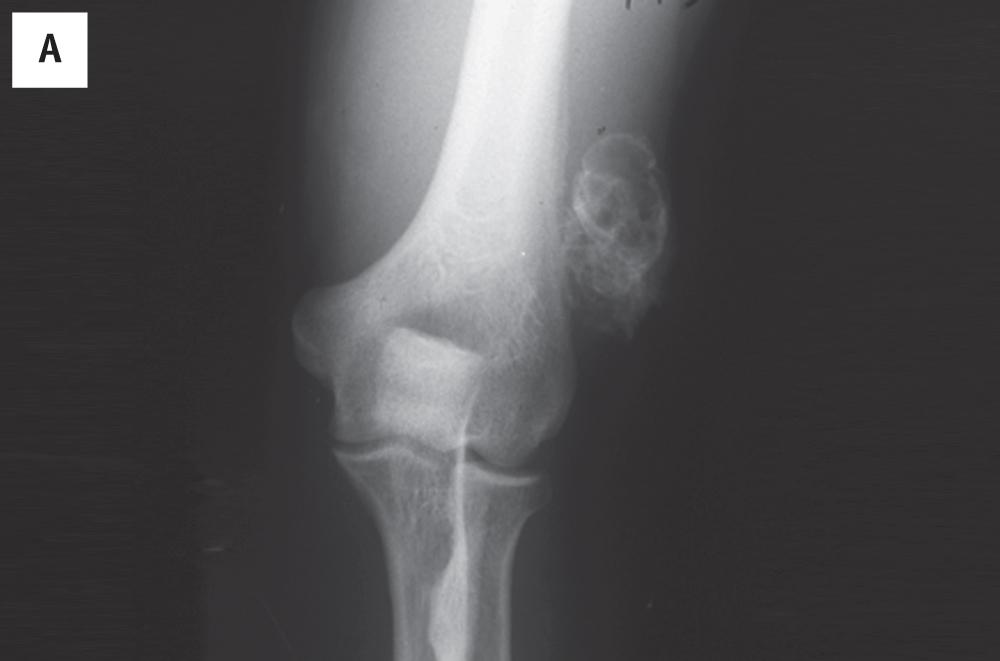
MO typically measures less than 5.0 cm, but lesions larger than 10 cm have been reported. Lesions examined early in their evolution are solid grey and may exhibit gritty tan regions of mineralized bone. More mature MO has the appearance of a solid bone that requires cutting with a saw ( Fig. 12.1B ). FOPDs are firm, rubbery, tan nodules that typically measure less than 3.0 cm in maximum size ( Fig. 12.2 ) and may be less well demarcated. Centrally the cut surface of ABCST demonstrates blood-filled spaces separated by thin strands of red-grey soft tissues ( Fig. 12.3 ).
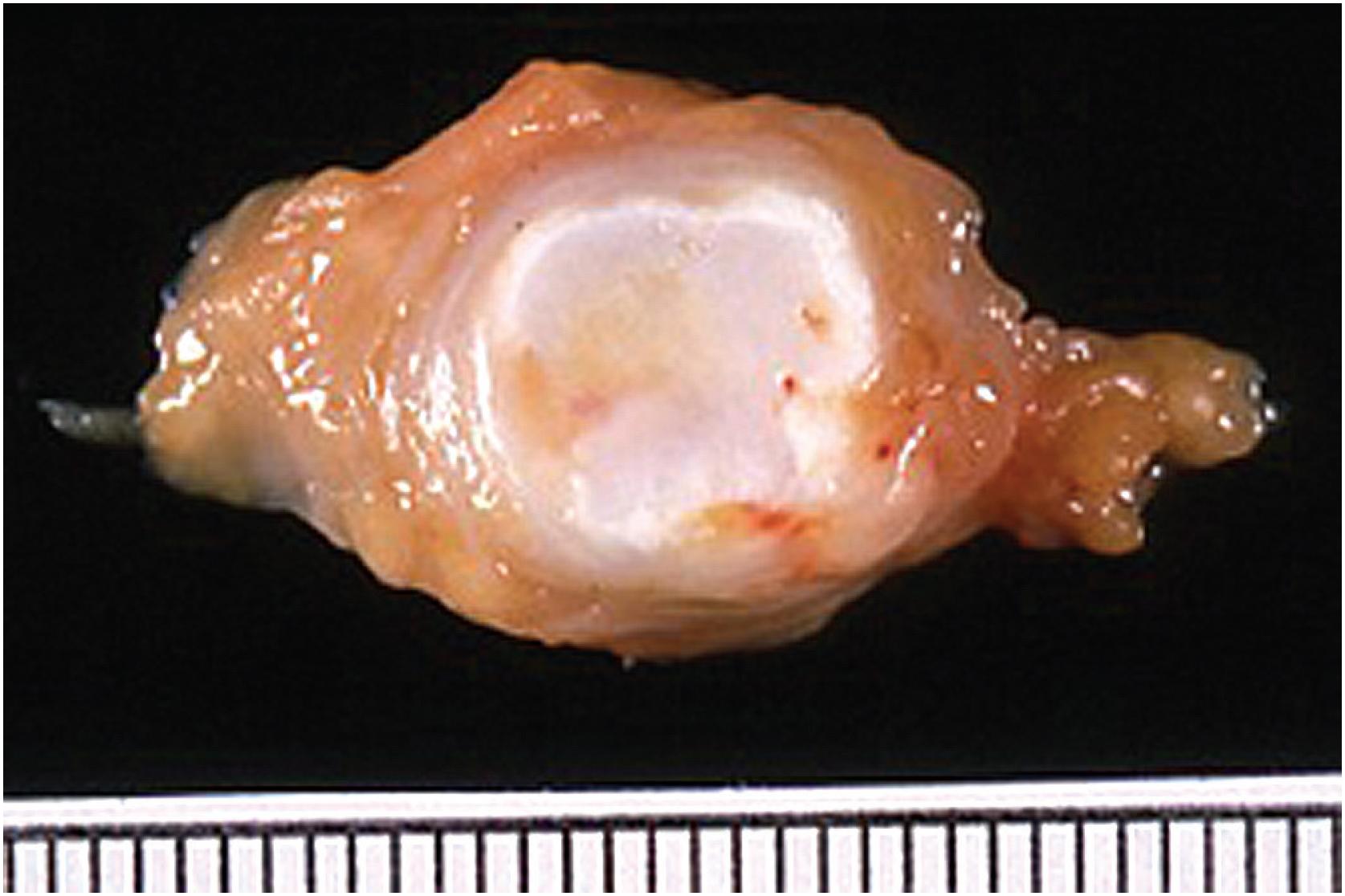
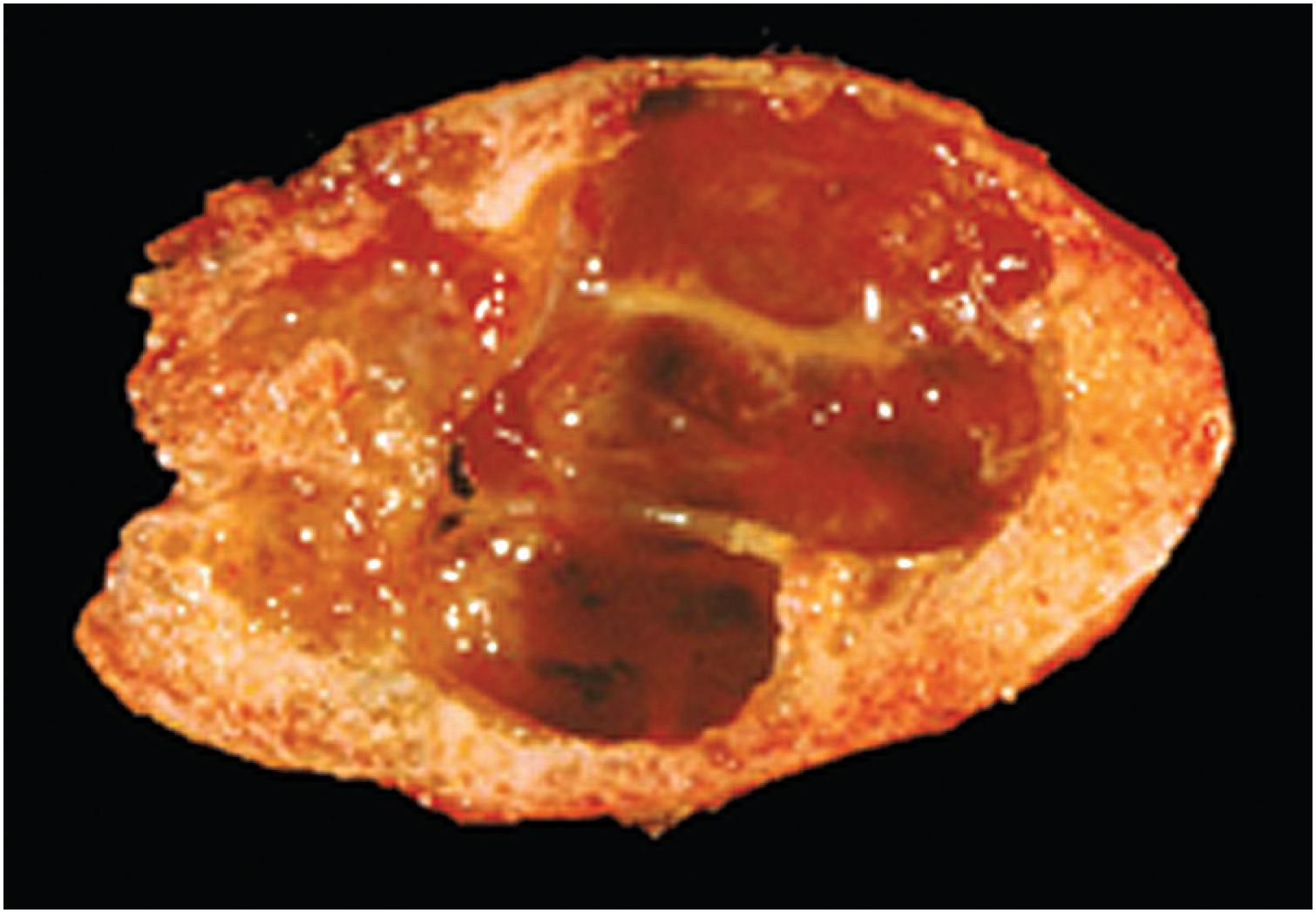
In the early phase, MO demonstrates increased cellularity composed of sheets and fascicles of plump, spindled myofibroblastic cells that assume a fasciitis-like picture ( Fig. 12.4A ). These cells, embedded within a myxoid to collagenous matrix, have oval nuclei with vesicular chromatin and eosinophilic nucleoli. Morphologically typical mitotic figures are usually readily found. Necrosis is usually not seen. Intersecting trabeculae of fibrillary eosinophilic osteoid appear to arise from the spindle cells ( Fig. 12.4B ). These immature foci of woven osteoid transition to thicker, more obvious, mineralized woven bone that shows prominent osteoblastic rimming. These, in turn, become continuous with more mature lamellar bone peripherally ( Fig. 12.4C ). Entrapped skeletal muscle is often found ( Fig. 12.4D ). This gradual transition in the histologic appearance from plump spindle cells through immature woven bone to mature lamellar bone is referred to as a zoning phenomenon. This is one of the key histologic hallmarks of MO ( Fig. 12.4E ). The degree to which this is identifiable will depend on the type of specimen. Although it is one of the most characteristic features of MO, it is not always represented on histologic materials. When prominent cystic spaces are present, which are surrounded by (myo)fibroblasts with interspersed osteoclast-like multinucleated giant cells, hemorrhage, and hemosiderin- laden macrophages, the diagnosis of ABCST might be rendered ( Fig. 12.4F ). FOPD is morphologically similar to MO, except that the distribution of osteocartilaginous matrix is haphazard and cartilage is more prominent ( Fig. 12.5A–D ).
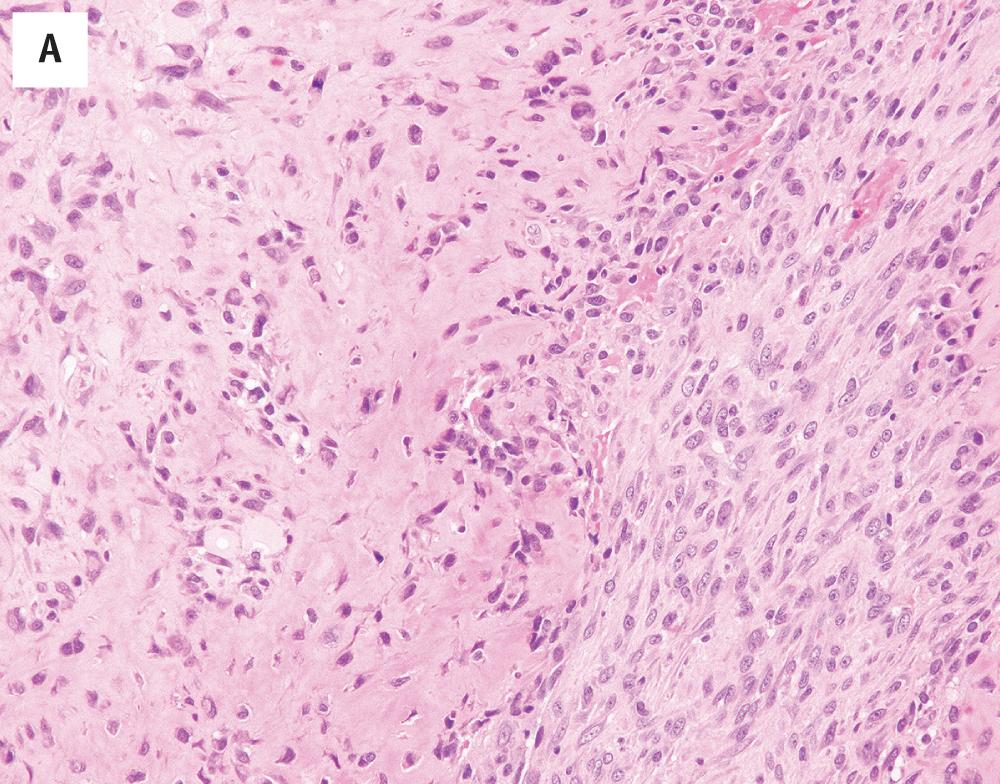
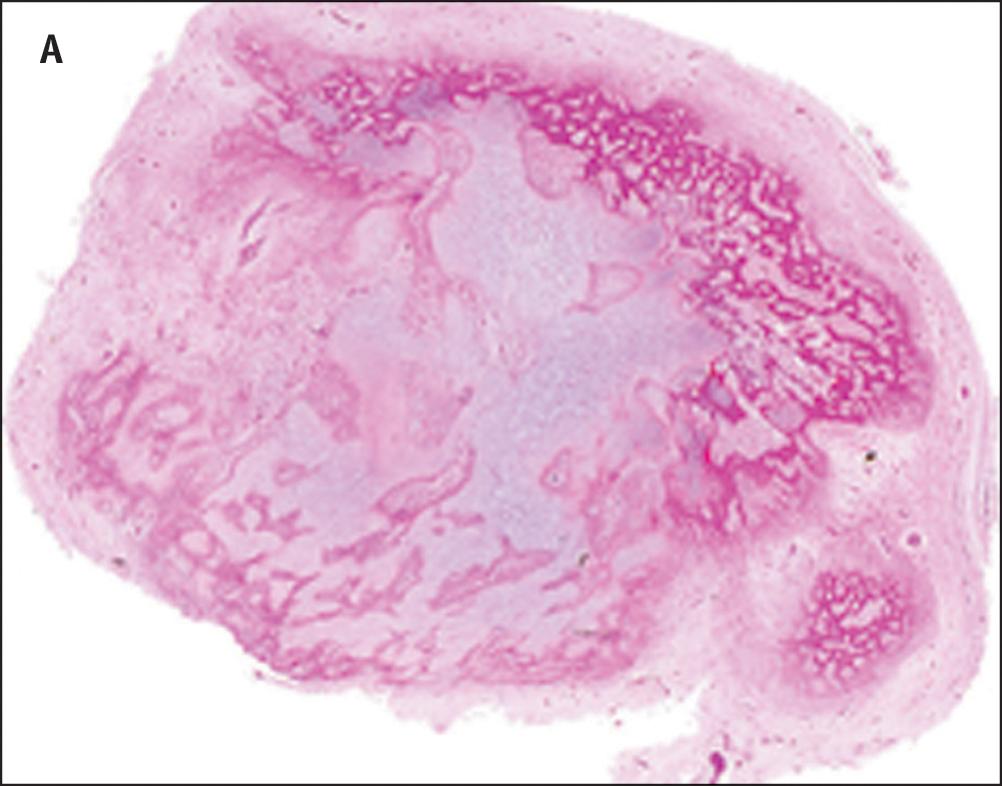
Similar to its osseous counterpart, ABCST frequently harbors USP6 fusion genes. However, unlike osseous ABC, where USP6 most commonly fuses with CDH11 , ABCSTs most often harbor COL1A1-USP6 fusions. USP6 fusion genes, most often COL1A1-USP6 , are also found in the majority of MO and FOPD, suggesting a close relationship between these unusual bone-forming soft tissue lesions.
The spindle cells that comprise the early phases of MO stain positively for smooth muscle actin and muscle-specific actin consistent with their myofibroblastic phenotype.
The USP6 gene rearrangement can usually be identified with FISH. RT-PCR and next-generation sequencing techniques are also viable alternatives.
The most important differential diagnostic consideration is soft tissue osteosarcoma (STO). Like MO, STO also occurs in the deep soft tissues, but it most commonly arises in patients in the fifth and sixth decades of life. STO is usually larger than 5.0 cm, grossly heterogeneous with hemorrhagic and necrotic regions, and histologically demonstrates nuclear pleomorphism and cytologic atypia (see later). STO generally lacks the zoning phenomenon as observed in MO, and the osteoid deposition quite often appears in the central areas of the tumor rather than at the periphery (so-called reverse zoning phenomenon). Soft tissue chondromas are better circumscribed, consist chiefly of cartilage, and often show dystrophic calcification and an osteoclastic giant cell reaction.
MO, FOPD, and ABCST are benign tumors that are treated by simple excision. Recurrence is extremely uncommon, even when resection margins are positive.
Self-limited benign bone-producing (myo)fibroblastic tumors that share common clinicopathologic and molecular features
Rare
The large muscles of the proximal extremities are most commonly involved in MO
FOPD usually involves fingers and toes
Benign tumors
MO slightly more common in male while FOPD slightly more common in female
Most common in the second and third decades of life
Short history of pain and swelling at the affected site
Preceding trauma is common (particularly in MO)
Uncommonly localized erythema
With plain radiographs, initially only a soft tissue mass may be visible
Lesions ossify as they mature
Magnetic resonance imaging in early lesions shows an inhomogeneous soft tissue mass
Cyst formation with fluid-fluid levels might be evident in ABCST
Local excision results in cure
Recurrence is extremely uncommon, even when excision margins are positive
Most lesions measure 5.0 cm or less
In early lesions, an ill-defined soft tissue mass may exhibit focal gritty calcifications
In more mature examples, the mass is completely ossified and readily demarcated from the skeletal muscle
FOPD is usually smaller and rubbery, and can be less demarcated
ABCST usually harbors hemorrhagic cystic spaces separated by thin strands of soft tissue
“Early” lesions – sheets of plump myofibroblastic-like spindle cells arranged as sheets and fascicles associated with intersecting trabeculae of lace-like woven bone
Mitotic figures are readily found
Necrosis is not present
“Later” lesions – bone is more mature and well organized
Zoning phenomenon
Fully mature examples are composed of lamellar cortical and cancellous bone that may contain fatty and hematopoietic marrow
Myofibroblastic pattern smooth muscle actin expression
The majority of cases contain USP6 rearrangement, mostly COL1A1-USP6 fusion gene
Soft tissue osteosarcoma (extraskeletal osteosarcoma)
Soft tissue chondroma
STOs arise in extraskeletal sites and are defined by the production of bone by the neoplastic cells. Most of these tumors are histologically high-grade and clinically aggressive.
STO occurs in adults with a peak incidence in the fifth and sixth decades of life. This is in contrast with skeletal osteosarcoma that most commonly occurs in younger patients. The tumors typically arise in the deep soft tissues of the proximal extremities, most commonly the thigh and buttocks, where they present as a painless mass. Rarely, patients may have a history of prior therapeutic irradiation at the site of the tumor. Males are affected approximately twice as frequently as females.
Usually, the tumors present nonspecific imaging characteristics that appear only as soft tissue masses. Radiographically detectable mineralization is uncommon.
STOs are usually large (often >10 cm), grossly heterogeneous tumors that exhibit regions of hemorrhage, necrosis or both ( Fig. 12.6 ). Like most soft tissue sarcomas, they may appear grossly circumscribed; however, they are microscopically infiltrative. Grossly detectable mineralized bone is not usually present.
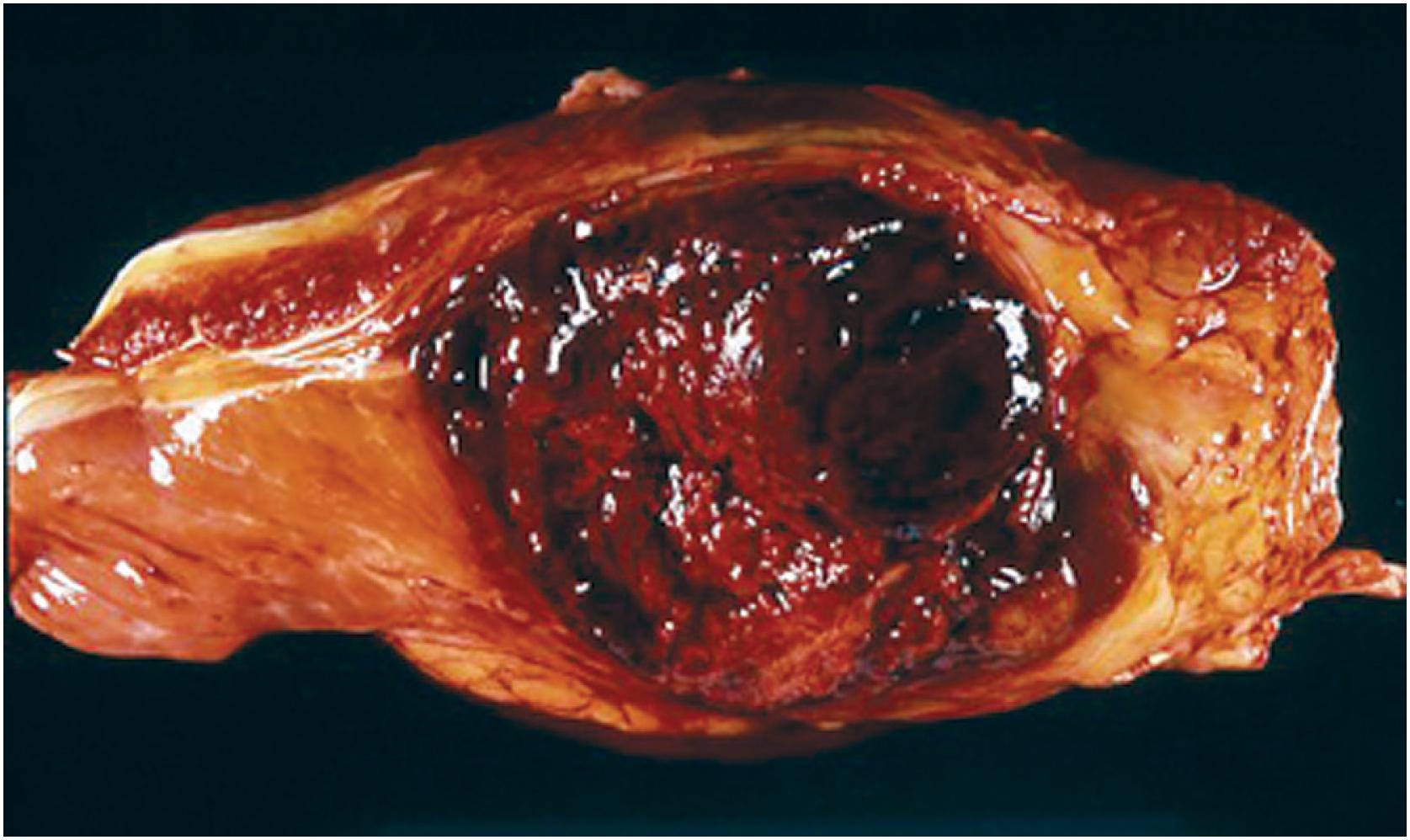
STOs are highly cellular, cytologically pleomorphic sarcomas ( Fig. 12.7A ). Most tumor cells are spindled to epithelioid in shape. The defining feature is the presence of neoplastic bone production. The bone usually outlines individual cells or clusters of cells in a “lace-like” manner; however, solid sheets of amorphous bone, with or without mineralization, may also be found ( Fig. 12.7B ). Bone production may only be focally present, and frequently the neoplasm has the appearance of an undifferentiated, spindle cell sarcoma. Lobules of highly cellular atypical cartilage may also be present ( Fig. 12.7C ). Any of the microscopic patterns seen in high-grade intraosseous osteosarcoma may be present in STO. Usually, the tumors demonstrate a high mitotic rate, including atypical mitotic figures. Necrosis may be prominent.
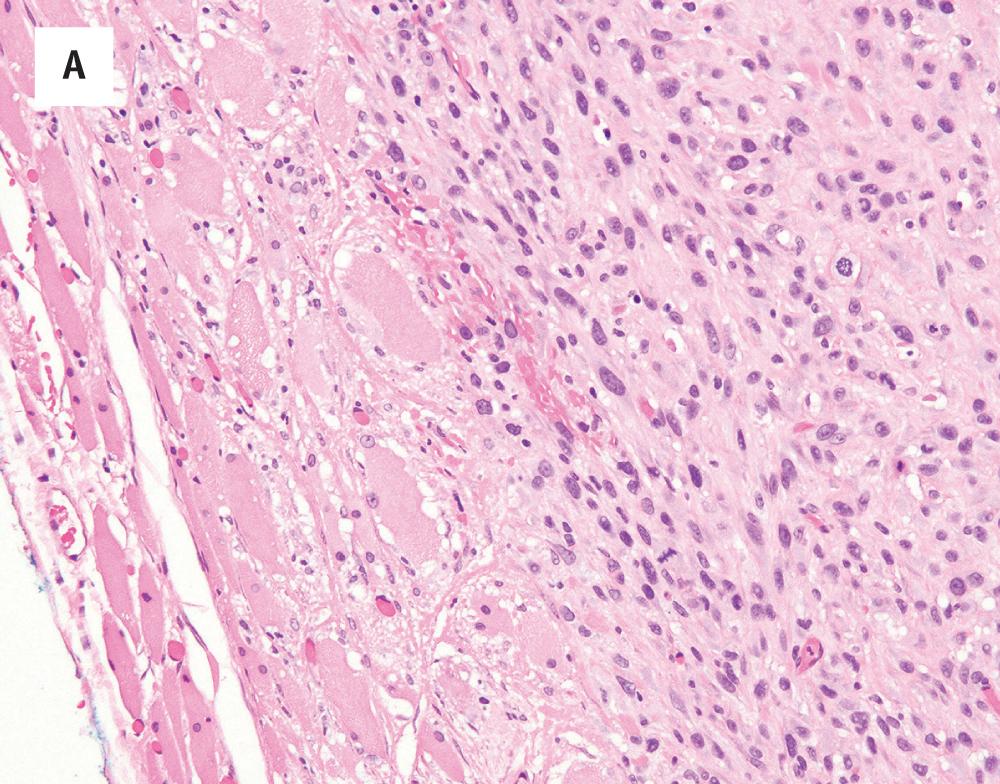
In general, immunohistochemistry is not especially helpful in the diagnosis of skeletal or extraskeletal osteosarcoma. As in skeletal osteosarcoma, STO may show limited expression of S100 protein, smooth muscle actins and occasionally keratins. Antibodies to the bone matrix protein osteocalcin and transcription factor SATB2 may offer diagnostic utility in differentiating scarce or indistinct osteoid from hyalinized collagenous stroma. The diagnosis of STO is principally a histologic one, with immunohistochemistry being used to exclude other soft tissue tumors in the differential diagnosis (see below).
Most STOs are high-grade tumors, and because the bone production may be a focal finding, the differential diagnosis includes other high-grade spindle cell sarcomas. Particularly in its early cellular phase with relatively scant bone production, MO is usually readily distinguished from STO by the uniform reactive appearance of the proliferating myofibroblastic and osteoblastic cells. High-grade nuclear atypia and atypical mitoses are characteristic of STOs but absent in MO. Clinical features (see earlier) also are usually of help in the distinction between the two entities. Soft tissue recurrence or metastasis of skeletal osteosarcoma will appear histologically identical to STO and can be recognized only by the history. The diagnosis of STO also requires the exclusion of other distinct sarcoma types with heterologous osteosarcomatous differentiation, particularly dedifferentiated liposarcoma (DDLPS) and malignant peripheral nerve sheath tumor (MPNST). For the most part, the diagnosis of DDLPS depends on the identification of a pre-existing well-differentiated component, although there may occasionally be a role for immunohistochemistry or FISH to demonstrate MDM2 amplification. Similarly, identification of areas of more conventional spindle cell MPNST, as well as origin from pre-existing neurofibroma, is typically key to the diagnosis of MPNST with heterologous osteosarcomatous differentiation. Mesenchymal chondrosarcomas may show foci of bone production, but consist of monotonous round to spindled cells arrayed about a prominent branching vasculature. Demonstration of the HEY1-NCOA2 fusion is diagnostic of mesenchymal chondrosarcoma.
STOs are high-grade tumors. Patients commonly present with metastatic disease, which accounts for the high mortality rate with these tumors. Treatment involves wide surgical resection and systemic chemotherapy.
A sarcoma arising in extraskeletal somatic soft tissue in which the neoplastic cells produce bone matrix
Rare
Most common in the deep soft tissues of the thigh and buttocks
High rate of metastases, and up to 75% of patients die of disease within 5 years of diagnosis
Rare examples of low-grade STO have a much better prognosis
Male individuals are affected approximately twice as often as female individuals
Most common in the fifth and sixth decades of life
As with most soft tissue sarcomas, patients present with a painless mass
Most of the tumors have nonspecific imaging features similar to other high-grade soft tissue sarcomas
Mineralization, if radiologically detectable, tends to be minimal
High-grade tumors, which form the majority, have a poor prognosis because of the high rate of metastases
Treatment is by wide surgical excision, with systemic chemotherapy
Often large (5–15 cm)
Hemorrhagic with focal necrosis
Calcification may be present
Pleomorphic spindle cell sarcomas with osteoid and bone production
May show any morphologic pattern seen in osteosarcoma of bone
Not usually required for diagnosis
SATB2 expression
Myositis ossificans
Osseous osteosarcoma (primary or metastatic/recurrent)
Other soft tissue sarcomas with heterologous osteosarcomatous component (especially dedifferentiated liposarcoma and malignant peripheral nerve sheath tumor)
Other high-grade pleomorphic sarcomas
STCs are benign tumors composed of mature chondrocytes associated with hyaline cartilage matrix. Although most are composed of well-formed hyaline cartilage, a chondroblastoma-like variant with greater cellularity and less matrix is also recognized.
Become a Clinical Tree membership for Full access and enjoy Unlimited articles
If you are a member. Log in here